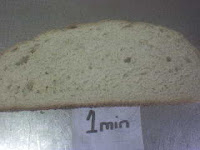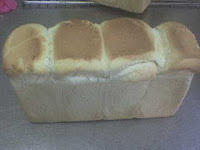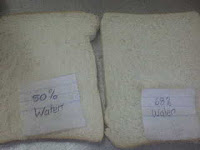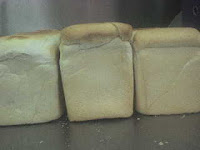Aim:
To observe and record temperature, texture, characteristics, and appearance results of mixing a dough at different intervals throughout the mixing process. Throughout the process removing 550grams of dough, proceed through the moulding and proving stages and the baking process of making the bread product white cobs.
Pre-Experiment Information:
Mixing has three main purposes:To combine ingredients into a uniform, smooth dough.To distribute the yeast evenly throughout the dough.To develop the gluten.When ingredients are mixed together along with flour and water, they form a dough, if a finished dough temperature is too high or too low, it can have a detrimental effect of the final quality of a product.
Method:
-Weigh up/ Construct a white dough using the recipe,
Bakers Flour- 100%
Salt-2%
Improver-1%
Yeast-2%
Vegetable Oil-1%
Water-60%
EYF= 1.66
-Begin the mixing process by starting the bowl
-After mixing has gone on for 1minute, 3minutes, 5minutes and 7minutes remove 550g of dough, and at the completion of mixing remove 55o grams of dough after the dough temperature has reached 28 degrees.
-Mould these pieces of dough and give proper intermediate proving
-Make the five pieces of dough into white cobs
-Tray cobs onto perforated tray and place into prover, when cobs are through the proving stage place cobs into oven and bake for 215 degrees for 18mins with steam.
-After baking is completed photograph the cobs together and singularly as a whole cob and photograph the cobs internally.
Results:
The pictures below represent each stage of the method from beginning to end. Temperature results are as follows,
The flour temp. was 21.2 degrees Celsius.
The water temp. used was 10 degrees Celsius.
The 550gram piece after 1min of mixings temp. was 20.3 degrees
The 550gram piece after 3mins of mixings temp. was 22.1 degrees
The 550gram piece after 5mins of mixings temp. was 24 degrees
The 550gram piece after 7mins of mixings temp. was 26.1 degrees
The 550gram piece after mixing was completed 28.1 degrees.
As can be seen in the pictures below the cobs improved with dough quality the longer it was spun, the first piece removed after 1minute of mixing was cold, sticky because it was still damp from the water, lumpy and full of hard flour clumps. The piece removed after 3mins of mixing was in better quality than the first piece but still cold and very inelastic. The 5min piece was beginning to see the formation of better quality dough, but yet this piece was spongy and very easily tore. The 7 min piece of 550 grams was warmer, and had some stretching ability to it. The final piece after the dough temp was 28 degrees was easily handled, had good temperature and elasticity, and was able to construct a perfect window test where as the other pieces could not.
1 minute mixed Cob
The external results for this cob was it had insufficient volume as it was too small from poor oven spring, as seen in the pictures below, the cobs top was not curved it was flat, the cob was torn and ragged, the crust colour was a pale brown compared to the cob removed at the end of mixing. The internal results for this cob were, it was still doughy (had an unbaked feel), it was hard and dense, had clumps of dough still present which resulted in its aroma still smelling doughy, had poor texture with lack of a grain and streaks. There were holes in the crumb and its crumb texture was very open and coarse. The crumb colour was a darker white compared to the completed mixed cob.
3 minute mixed Cob
Much can be said about this cob as the same with the 1 minute mixed cob except with a slight improvement within the crust character and oven spring for its external results. It crust was still not “crusty” as it was under developed; again it is still too small in volume and was pale in colour. The internal results were again an improvement, the crumb structure again was too compacted which resulted in the irregular shape and size of the cells, and still the cob was doughy and had a not so soft feel. There were holes present within the crumb which resulted with open and coarse texture. The crumb colour was still darker than the completed mixed cob (as seen below in the pictures).
5 minute mixed cob
The external results for the cob were better oven spring resulting in the better seen volume in the pictures below. The crust colour was beginning to darken up compared to the two cobs previously. The crust character was beginning to bloom, with the beginning of a shiny coat, and the improvement of shape and symmetry. The internal results for this cob were improvements with the crumb colour, and texture, the open and coarse holes were becoming less present, and the feel became softer and felt signs of better strength. The aroma scented the smell of fresh baked bread. However, there was still very small patches of crust clumps present.
7 minute mixed cob
The external results for this cob were of coarse the best of the 4 cobs removed from the bowl before reaching the dough FDT (final dough temperature), it shown better crust colour being a more golden brown, this piece was well more developed than the previous pieces. It has a sufficient oven spring and crust character. The shape has improved and now shows an even grain forming. The internal results for the 550 gram piece were the crumb colour near to perfect; not being too pale or too dark and dense, the holes within the crumb had vanished. The crumb texture showed good evenness and shape.
Completed Mixed cob
The external results for this cob were loaf were its volume (Size) was in good quality of volume, with perfect size, this cob will be easily packaged and sliced as it has normal volume aspects. This cob had a good resulting oven spring. The crust colour was lightly baked brown colour, perfectly desired colour, and shown a nice glossy type shine. The Crust Character shown that it had a perfect crust character, with shiny coat, nice soft texture with regular shape and even grain. The internal results were the crumb colour was neither pale nor dark, perfectly white. The Crumb Softness was a perfect moist centre, not to dense or tough. Perfectly baked causing no doughyness, or poor strength. The Crumb was an even thickness, perfected even grain. Regular shaped, and regular sized cells. This pieces aroma was a perfect fresh smell, not yeasty, bland, sour nor salty. As can be seen in the pictures this cob was the best of the 5 cobs produced.
Conclusion:
This experiment determined why it is important to mix a dough to the doughs desired FDT (Final Dough Temperature) in this dough it being 28 degrees. By correctly completing this procedure will result in a better quality of product.
Pictures:


































































 Loaf on left is loaf with 68% water, middle loaf is loaf with 50% water and right loaf is 60% water.
Loaf on left is loaf with 68% water, middle loaf is loaf with 50% water and right loaf is 60% water.